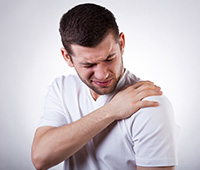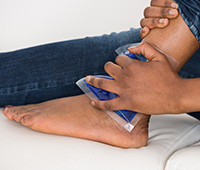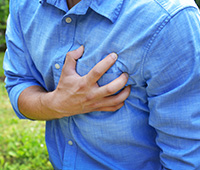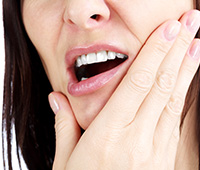WHAT IS Shoulder Pain
- Definition
- Causes
- Symptoms
- Diagnosis
- Ayurvedic Tips
- FAQS
- References
Definition

Shoulder pain is any pain in or around the shoulder joint. The rotator cuff (A group of 4 muscles and their tendons) gives the shoulders its wide range of motion. Swelling, damage, or bone changes around the rotator cuff can cause shoulder pain. You may have pain when lifting the arm above your head or moving it forward or behind your back.1
Ayurveda describes shoulder pain as Apabahuka- a disease that affects the shoulder joint and is produced due to aggravation of the Vata dosha.2
Disclaimer: The information on this page is not intended to be a substitute for professional medical advice. Do not use this information to diagnose or ayurvedic treatment of pain and/or shoulder pain without consulting the doctor. Consult your physician before beginning an exercise regime. "While we have products /ayurvedic medicines for pain and/or shoulder pain, you must consult an authorized physician before taking any of the products. For more information on products, visit www.dabur.com or call 1800-103-1644"
Causes
Causes OF Shoulder Pain
The most common reason for shoulder pain is when rotator cuff tendons become trapped under the bony area in the shoulder. The tendons become inflamed or damaged.1
Shoulder pain may also be caused by:1
- Swelling in the shoulder joint
- Bone abnormalities in the shoulder area
- Infection inside the fluid that normally protects the joint and helps it move smoothly
- Broken shoulder bone
- Dislocation of the shoulder - the ball bone comes out of the socket
- Shoulder separation
- Frozen shoulder – shoulder muscles become stiff, making movement difficult and painful
- Overuse or injury to muscles of the arms
According to Ayurveda, the causes of Apabahuka may be classified into two groups:2
(i) Bahya hetu — Caused due to injury to the shoulder joint
(ii) Abhyantara hetu — Caused due to Indulging in the causative factors that aggravate Vata dosha, leading to the aggravation of vata in that region. This disturbs the integral stability of the joint and results in restricted movement with painful and stiffened joints.
Disclaimer: The information on this page is not intended to be a substitute for professional medical advice. Do not use this information to diagnose or ayurvedic treatment of pain and/or shoulder pain without consulting the doctor. Consult your physician before beginning an exercise regime. "While we have products /ayurvedic medicines for pain and/or shoulder pain, you must consult an authorized physician before taking any of the products. For more information on products, visit www.dabur.com or call 1800-103-1644"
Symptoms
Symptoms OF Shoulder Pain
Symptoms of shoulder pain are varied depending upon the part of shoulder that is affected and the cause of damage:3
Instable shoulder | Dislocated shoulder | Shoulder joint disease |
|
|
|
Disclaimer: The information on this page is not intended to be a substitute for professional medical advice. Do not use this information to diagnose or ayurvedic treatment of pain and/or shoulder pain without consulting the doctor. Consult your physician before beginning an exercise regime. "While we have products /ayurvedic medicines for pain and/or shoulder pain, you must consult an authorized physician before taking any of the products. For more information on products, visit www.dabur.com or call 1800-103-1644"
Diagnosis
Diagnosis OF Shoulder Pain
Your doctor may diagnose your shoulder problems by:4
- Taking you medical history
- Performing a physical examination
- With the help of tests such as x rays, ultrasound, and magnetic resonance imaging (MRI)
Disclaimer: The information on this page is not intended to be a substitute for professional medical advice. Do not use this information to diagnose or ayurvedic treatment of pain and/or shoulder pain without consulting the doctor. Consult your physician before beginning an exercise regime. "While we have products /ayurvedic medicines for pain and/or shoulder pain, you must consult an authorized physician before taking any of the products. For more information on products, visit www.dabur.com or call 1800-103-1644"
Ayurvedic Tips
Ayurvedic Tips Shoulder Pain
Your doctor may diagnose your shoulder problems by:4
- Taking you medical history
- Performing a physical examination
- With the help of tests such as x rays, ultrasound, and magnetic resonance imaging (MRI)
Diet Recommendations (Aahar)
A Vata balancing diet is recommended in joint pain related conditions. These include:2,5
- Grains: Rice, cooked oatmeal, whole wheat and whole grain breads (toasted)
- Pulses: Yellow split mung beans (green skin removed), whole mung beans, red lentils and tofu
- Vegetables: : Zucchini, asparagus, carrot, beets, sweet potatoes, cucumber, lady finger, parsley, green peas, fennel, spinach in small amounts and cooked coconut. All should be cooked well so they are soft.
- Spices: Cumin, ginger, mustard seeds, ajwain, celery seeds, fenugreek, coriander, bay leaves, basil, saffron, hing (asafoetida), cinnamon, cardamom, cloves, anise, fennel, black pepper (in small amounts)
- Fruits: All ripe, sweet, and juicy fruits. Sweet grapes, banana, melons, plums, cherries, mango, papaya, pomegranate, sweet pineapples, raisins, sweet oranges, dates and figs, avocado, apples and pears.
- Oils: Ghee or organic olive oil
- Sweeteners: Honey, jaggery, date sugar
Lifestyle changes (Vihar)
Exercises that directly or indirectly influence the shoulder are considered good for managing this kind of pain: 2,6(Yoga should practised under guidance)
 Baddha Padmasana (Locked Lotus pose)
Baddha Padmasana (Locked Lotus pose) Akarna Dhanurasana (bow and arrow pose)
Akarna Dhanurasana (bow and arrow pose)
Disclaimer: The information on this page is not intended to be a substitute for professional medical advice. Do not use this information to diagnose or ayurvedic treatment of pain and/or shoulder pain without consulting the doctor. Consult your physician before beginning an exercise regime. "While we have products /ayurvedic medicines for pain and/or shoulder pain, you must consult an authorized physician before taking any of the products. For more information on products, visit www.dabur.com or call 1800-103-1644"
FAQS
FAQS
1. Can Ayurveda treat foot pain?
In Ayurveda, foot care is considered very important since it is known to benefit the entire body and nervous system in a holistic manner. There are certain points in our body called marma or vital points, where our vital energies are concentrated. Feet and ankles also have these vital points, which if not taken care of, can cause problems like chronic pain in the ankles, pain and swelling in feet, etc. Ayurveda can play a significant role in managing ankle pain with a combination of corrective Ahar (diet), Vihar (exercise) and Aushadhi (Medicines) regime.
2. What kind of diet and exercises will be helpful in reducing neck pain?
To reduce neck pain, Ayurveda suggests following diet and exercises:
- Take lots of fruits, green vegetable salads and sprouts.
- Good hydration will help retain neck health.
- Avoid refined foods and junk foods.
- Milk is an important source of Calcium and can help maintain healthy bones.
- Vitamin C in citrus fruits will help the healing process.
- Honey in warm water or herbal teas are good for cleansing the bowels and this will help relieve many backaches that are due to constipation.
Pranayama (breathing exercises) is a powerful way to promote relaxation and a pivotal first step towards relieving muscle tension. Slow, deep breathing & relaxation can stimulate a sense of calmness and cause reduction in pain.
Yoga Asanas are also beneficial in maintaining neck and overall health
- Balasana
- Marjaryasana
- Bhujangasana
3. I have knee pain. What could be the reasons for it?
Knee pain can have different causes. Being overweight puts you at greater risk for knee problems. Overusing your knee can trigger knee problems that cause pain. If you have a history of arthritis (swelling of knee joint), it could also cause knee pain.
Medical conditions that can cause knee pain are
- Arthritis – Rheumatoid arthritis, Osteoarthritis, Gout
- Infection in the knees / knee joint
- Injuries – fracture, dislocation, sprained knees etc.
- Cancer
4. What can I do to reduce my knee pain?
Ayurveda suggests following diet and lifestyle changes to help reduce knee pain.
Include more foods containing
- Pulses: Black gram, green gram
- Vegetables & spices: Onion, garlic, sesame seeds, ginger, radish, ladies finger, pumpkin
- Fruits: pomegranate, mango, grapes
- Oils: Ghee
Ayurveda recommends regular, slow and gentle exercises with adequate rest to knee joints. Regular Pranayama and Yoga Nidra is also recommended.
- Avoid prolonged walking, standing, kneeling and squatting and crossed leg sitting.
- Yoga asanas: Makarasana, Pavanamuktasana, Dhanurasana, Vakrasana
5. I have tingling pain in the legs. Is it sciatica?
Sciatic pain most often occurs on one side of leg or hip. Symptoms of sciatica pain can vary widely as mentioned below:
- Mild tingling
- Dull aching that radiates from buttock to back of whole leg
- Burning sensation
- Inability to move leg when pain becomes severe
The pain often starts slowly and may get worse:
- After standing or sitting
- At night
- When sneezing, coughing, or laughing
6. What diet is effective in reducing the sciatica pain?
A healthy diet for controlling sciatica pain is for balancing Vata dosha and includes:
- Grains: Rice, cooked oatmeal, whole wheat and whole grain breads (toasted)
- Pulses: Yellow split mung beans (green skin removed), whole mung beans, red lentils and tofu
- Vegetables: : Zucchini, asparagus, carrot, beets, sweet potatoes, cucumber, lady finger, parsley, green peas, fennel, spinach in small amounts and cooked coconut. All should be cooked well so they are soft.
- Spices: Cumin, ginger, mustard seeds, ajwain, celery seeds, fenugreek, coriander, bay leaves, basil, saffron, hing (asafoetida), cinnamon, cardamom, cloves, anise, fennel, black pepper (in small amounts)
- Fruits: All ripe, sweet, and juicy fruits. Sweet grapes, banana, melons, plums, cherries, mango, papaya, pomegranate, sweet pineapples, raisins, sweet oranges, dates and figs, avocado, apples and pears.
- Oils: Ghee or organic olive oil
- Sweeteners: Honey, jaggery, date sugar
7. I frequently get gas pain. What food types are good for me?
Following foods are good to help relieve gas pain:
- Grains: Whole wheat thick flat bread or chapati, millet & sorghum bhakri, unpolished rice
- Pulses: Chickpea, Tur dal, Masoor Moong
- Vegetables: Carrots, Radish, Lauki, potatoes, white gourd, spiny gourd, , cucumber, ajwain, guar bean, eggplant, amaranth, cabbage, spinach, coriander seeds and leaves, sweet potatoes, tomatoes, green chillies, lady finger
- Fruits: , pears, papaya, pineapple, pomegranate, oranges, unripe bananas, water chestnut, dry fruits – almonds, walnuts, peanuts, dry dates, apples, grapes etc.
- Oils: Ghee, coconut oil in small quantities
- Ginger, cumin, coriander should be preffered in spices.
8. What is trigeminal neuralgia?
Trigeminal nerve (TN) pain is a nerve condition that causes a stabbing or electric-shock-like pain in parts of the face.
It usually affects one side of the face. Any vibration on your face, even from talking, brushing etc. can set it off. The condition may come and go, disappearing for days or even months. But the longer you have it, the less often it goes away. TN pain usually affects women and people above 50 years of age.
Ayurveda describes 11 types of shiro rogas (headaches), among which trigeminal nerve type of pain is called ‘Ardhavabhedaka’. It happens when aggravated doshas (Vata, Pitta and Kapha) press on the neck and throat producing a powerful burning sensation, out of which comes excruciating pain. This pain ultimately affects the eyes, eyebrows and temples.
9. How can Ayurveda help in relieving stomach pain?
Ayurveda describes a comprehensive approach towards managing stomach pain- the most commonly diagnosed conditions being constipation (Vibandha) and indigestion (Ajirna)
Constipation is used to indicate fewer bowel movements, hard stools, painful defection and feeling of bloating, abdominal pain or incomplete elimination.
Indigestion, on the other hand, is an abnormality that occurs in digesting food or lack of proper digestion resulting in stomach pain, burping or flatulance (abdominal gas).
Ayurveda can play a significant role in managing & preventing different stomach pains by practising a combination of corrective Ahar (diet), Vihar (exercise) and Aushadhi (Medicines) regime
Corrective Ahar for both constipation & indigestion includes:
Grains: Wheat, unpolished rice, barley
- Pulses: Green gram, chickpeas, course corn, Toor dal, moong, masura lentils, Vegetables/Spices: Garlic, Asafetida, long pepper, sunthi (dry ginger), green leafy vegetables, cucumber, bitter gourd, pointed gourd, cabbage, dates, betel nut, turmeric
- Fruits: High fibre fruits such as apples, pears, papaya, grapes, amala, haritaki
- Oils: Ghee
Exercise: Regular exercise, meditation and practice of asanas purifies the blood, improves the appetite, increases the will power and makes the patient physically active. The whole alimentary canal improves and becomes regular.
Yoga Asanas: Vajrasana (after every meal), Kurmasana, Vakrasana, Katichakrasana
Pranayama: Surya anulom viloma, deep relaxation technique
10. What is myofasial pain?
Myofascial pain disorder (MPS) refers to pain and swelling in the body's soft tissues or muscles. Myofascial pain is a long-term, painful condition that affects the connective tissue that cover the muscles. It is considered as a type of muscular pain (fibromyalgia) which happens at specific areas on the body.
Myofascial pain might involve either a single muscle or an entire muscle group. In some cases, the area where you experience the pain might not be where the myofascial pain is generated. The actual location of the injury leads to the development of a trigger point, which in turn causes pain in other areas. This is known as referred pain
Disclaimer: The information on this page is not intended to be a substitute for professional medical advice. Do not use this information to diagnose or ayurvedic treatment of pain and/or shoulder pain without consulting the doctor. Consult your physician before beginning an exercise regime. "While we have products /ayurvedic medicines for pain and/or shoulder pain, you must consult an authorized physician before taking any of the products. For more information on products, visit www.dabur.com or call 1800-103-1644"
References
References
- Shoulder Pain. MedLine Plus. 2015. https://medlineplus.gov/ency/article/003171.htm
- Das B, et al. A study on Apabahuka (frozen shoulder) and its management by Laghumasha taila nasya. Ayu. 2010 Oct-Dec; 31(4): 488–494.
- Shoulder pain – Causes. NHS Choices. [Cited 2016 August 29]. http://www.nhs.uk/Conditions/shoulderpain/Pages/Causes.aspx
- Shoulder Problems. NIH NIAMS. November 2014. [Cited 2016 August 29]. http://www.niams.nih.gov/health_info/shoulder_problems/shoulder_problems_ff.pdf
- Vata Pacifying Diet. Amrita Veda Ayurveda. [document on the internet]. [Cited 2016 August 29]. Available at: http://www.amritaveda.com/learning/articles/vatachart_back_bw_final.pdf
- Swami Satyananda Saraswati. Asana Pranayama Mudra Bandha. [document on the internet]. [Cited 2016 August 29]. Available at: http://sriyogapeeth.com/ebooks/swami-satyananda-saraswati---asana-pranayama-mudra-bandha.pdf
Disclaimer: The information on this page is not intended to be a substitute for professional medical advice. Do not use this information to diagnose or ayurvedic treatment of pain and/or shoulder pain without consulting the doctor. Consult your physician before beginning an exercise regime. "While we have products /ayurvedic medicines for pain and/or shoulder pain, you must consult an authorized physician before taking any of the products. For more information on products, visit www.dabur.com or call 1800-103-1644"




